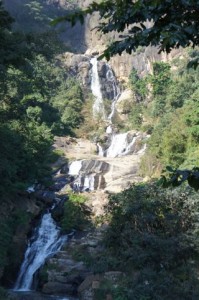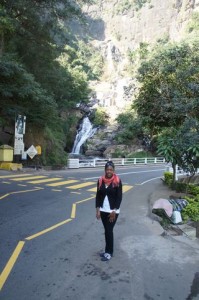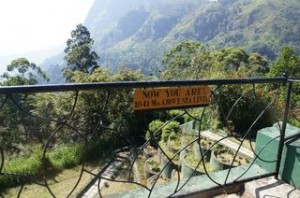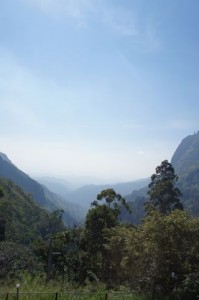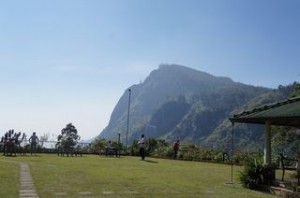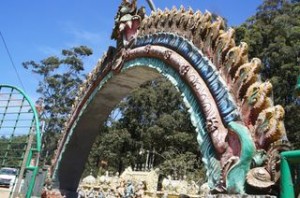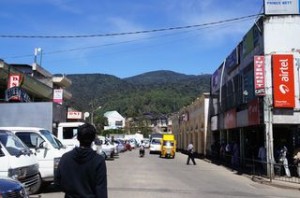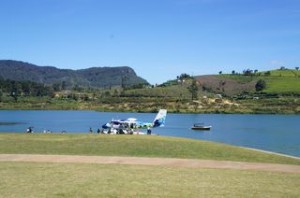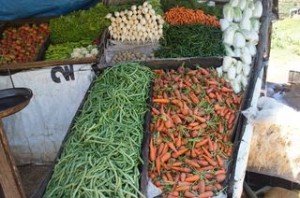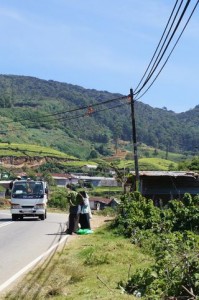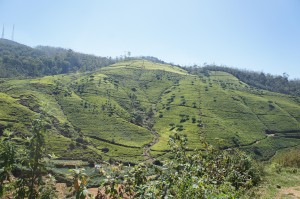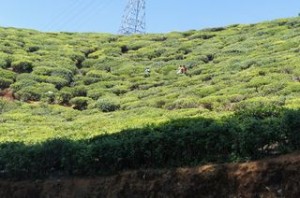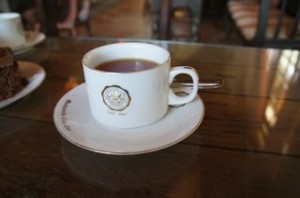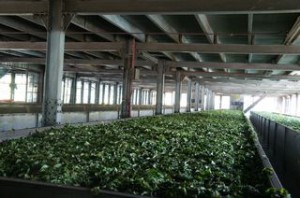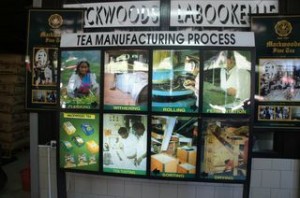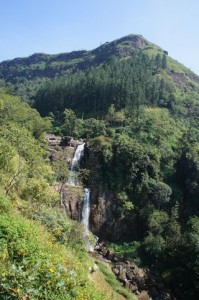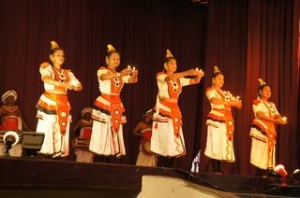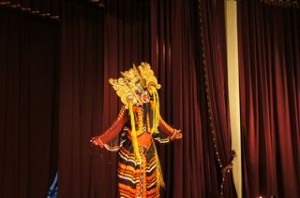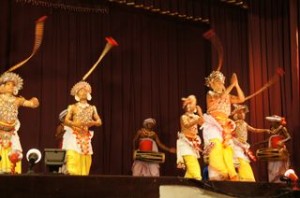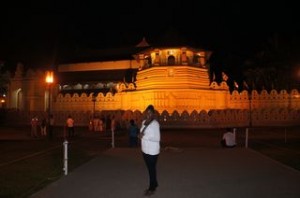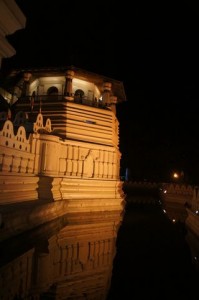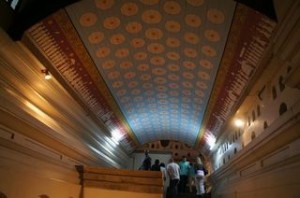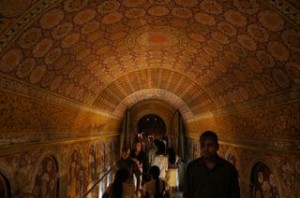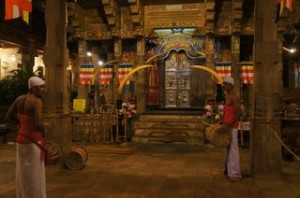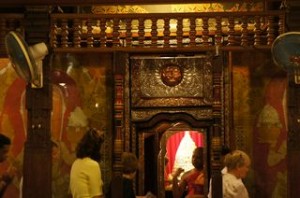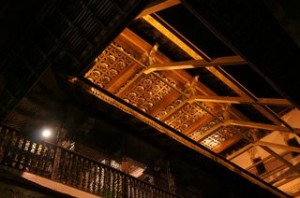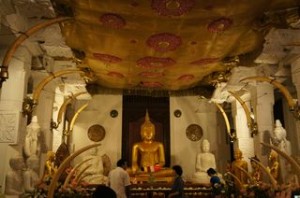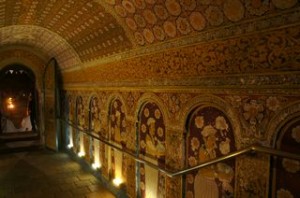Sid looks back and asks if I’m OK. I nod even though I’m not really OK. I got too much sun on the safari yesterday, not thinking to bring my hat. I got too little sleep, and I think the buffalo curd from last night is curdling in my stomach. But I’m trying to power through the nausea. We are weaving our way higher and higher into the mountains toward tea country along the A2, which has turned into a relentless winding road. The second time he asks if I’m OK, I’m ready to barf, literally. My hand is over my mouth. Sid sees my distress and tells Pradeep to pull over. Seconds after the van door is open, I’m hurling onto a dirt mound on the side of the road. Sometimes the travel gods don’t smile and decide to play a few tricks on you instead. Once rid of the contents of my stomach, I feel immensely better, but we go on a hunt for ginger beer to keep my stomach calm just in case. I start to realize that I may have a problem with traveling in high altitudes. I remember feeling similarly queasy on a bus ride through the Atlas Mountains in Morocco a few years ago.
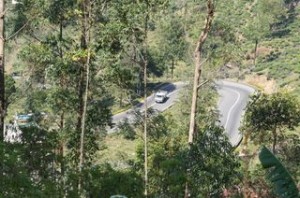 All was well a few miles back, when were standing in front of the Rawana Ella waterfall, a picturesque flow of water that seems to spring from some secret place within the mountainside and rush under the road we are traveling. It’s the first place that I see monkeys scampering about. One has incurred the ire of one of the vendors along the road, having stolen something from his stand. As we head back to the van, we are followed by a couple of local men offering crystalized rocks as souvenirs. I tried to refuse them, but they placed the rocks firmly in my hands and we were obliged to give them a few rupees. Sid says they get the rocks from the falls to sell to tourists. We are in Ella, a stunning mountain village, and a drastic change in scenery from the southern beaches we drove along just yesterday. We continue our ascent through the verdant hills and make another stop at the Grand Ella Motel, which has the best vantage point for lush landscape viewing. A patchwork quilt of farms and tea plantations unfold below us and green peaks and valleys stretch as far as the eye can see. The motel itself is lovely with a landscaped terrace that takes advantage of its breath-taking location.
All was well a few miles back, when were standing in front of the Rawana Ella waterfall, a picturesque flow of water that seems to spring from some secret place within the mountainside and rush under the road we are traveling. It’s the first place that I see monkeys scampering about. One has incurred the ire of one of the vendors along the road, having stolen something from his stand. As we head back to the van, we are followed by a couple of local men offering crystalized rocks as souvenirs. I tried to refuse them, but they placed the rocks firmly in my hands and we were obliged to give them a few rupees. Sid says they get the rocks from the falls to sell to tourists. We are in Ella, a stunning mountain village, and a drastic change in scenery from the southern beaches we drove along just yesterday. We continue our ascent through the verdant hills and make another stop at the Grand Ella Motel, which has the best vantage point for lush landscape viewing. A patchwork quilt of farms and tea plantations unfold below us and green peaks and valleys stretch as far as the eye can see. The motel itself is lovely with a landscaped terrace that takes advantage of its breath-taking location.
Back on the road, we are on our way to Nuwara Eliya, known as “Little England” and the “tea capital” of Sri Lanka. The Brits settled here in the 1800s and found that they could successfully grow their favorite fruits and vegetables as well as tea. One of the Brits was named Lipton and he made his fortune in Sri Lanka, known as Ceylon at the time, explaining why we still see the name Ceylon associated with tea, too. And, another bit of history reveals that the Brits brought the Tamils from southern India with them to Sri Lanka as laborers, which may have been the beginnings of the conflict farther north in Jaffna between the Tamils and Sinhalese. Before we make it to Nuwara Eliya, a series of small ornate structures appear along side the road. The Seetha Amman Temple looks out of place here, but it is a beautiful contrast to the deep green trees and hills just beyond it. As South Asian myth would have it, this Hindu temple marks the place where the evil demon king Ravana imprisoned Seetha, the wife of Lord Rama, in Sri Lanka. Lord Rama would bring a massive army to rescue his wife, defeating his rival and taking her back to India. The golds, reds, blues and greens of the painted temple are vibrant in the sun and its small posed statues seem to smile in the face of it.
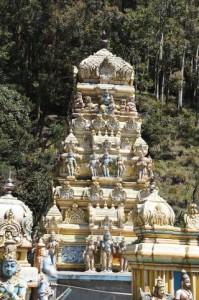 We take a longer rest in Nuwara Eliya to stretch our legs and for me to continue recovering from any altitude sickness. The “tea capital” seems relatively small and quaint for a place that was a British center of agriculture. But there is commerce going on in this place neatly nestled in the mountains with a small market selling touristy trinkets and t-shirts. A short distance away, tourists can fly into Nuwara Eliya by a sea plane that lands on a river lined by homes and maybe guest houses with red, blue and orange tiled roofs.
We take a longer rest in Nuwara Eliya to stretch our legs and for me to continue recovering from any altitude sickness. The “tea capital” seems relatively small and quaint for a place that was a British center of agriculture. But there is commerce going on in this place neatly nestled in the mountains with a small market selling touristy trinkets and t-shirts. A short distance away, tourists can fly into Nuwara Eliya by a sea plane that lands on a river lined by homes and maybe guest houses with red, blue and orange tiled roofs.
Now, it’s time to see how all the tea we’ve seen bursting from the hillside is cultivated and produced. I’ve had a cup of tea almost every morning that I’ve been in Sri Lanka and it is good with a bit of sugar or without, especially if you are a fan of strong black teas like English Breakfast. We are deep in tea country as we approach the Mackwoods Labookellie Tea Estate, passing terraced tea bushes as far as the eye can see and a few of the women who pick the best of the leaves from them for a living. Mackwoods is a tourist destination. When we pull up, we see groups of Germans and Brits departing with gift bags of tea and trinkets. Inside the restaurant and gift shop, I have a cup of the famous black tea with chocolate cake before a guided tour of the factory. Here are a few tea facts that I picked up: The factory employs 650 women who hand pick the top leaves from tea bushes on 15 tea estates. The women will go out to pick from bushes 50 times a year. (Sid and Pradeep tell me that many of these women don’t get paid very much, maybe $2 or $3 for a day’s work.) The very top and smallest leaves yield the finest and darkest tea, while lower leaves, or fannings, yield a lighter, milder tea. It takes 5 kilograms (11 pounds) of picked tea leaves to make one kilogram (2 pounds) of dried tea. Overall, it seems like a pretty tedious process with many steps from further sorting and withering, where leaves are turned by hand every 5 hours in a process that takes 14 hours in total, through rolling by machine, natural oxidation on tile floors, then drying and any plucking of remaining stems by machine. I leave Mackwoods like the British and German tourists who left before me– with boxes of pure Ceylon tea.
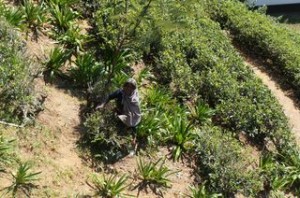 Before heading to our final destination of the day, Kandy, we make a quick stop at another one of Sri Lanka’s waterfalls, Ramboda, which we view from inside the Ramboda Falls Hotel. Again, we try to pinpoint the source of the rushing waters down a rock face that seems higher than the one we saw at Rawana Ella. We are still driving north on A2 when we reach Kandy, the capital of the last Sinhalese kingdom before Sri Lanka fell under British rule in 1815. The people here seem to be proud of their royal and cultural roots, and after we’ve deposited our bags at the absolutely adorable Riverside Holiday Home there, Sid and I take in some of this traditional Sinhalese culture in a showcase of dances at the Kandyan Cultural Center Hall. The place is packed and it’s the first time that I’ve been with such a large number of tourists on my trip. More tourists stream into the modest hall and more chairs appear to accommodate them. Finally, the show starts with the blowing of a conch shell and men appear in white turban-like headdresses and sarongs, rhythmically beating drums and women with Dr. Seussian shaped horns sing a high-pitched tune. The show gets more elaborate with Pooja dancers wearing golden ear coverings as they pay homage to the gods, men in vests made of beads spin, twirl and somersault with an instrument similar to a tambourine, then a there’s a mask dance where a mythic bird kills a snake to drive away evil spirits. In the Ves dance, the dancers wear a traditional outfit made of 64 ornaments, including a long tassle that they flip and whirl from the top of a heavy headdress. For the finale, the audience starts to shift with groups of people sitting on stage and focusing their attention on wooden planks on the floor in between the stage and the audience. There’s another conch shell call and two bare-chested men emerge with fire torches that the proceed to rub across their bodies and lick with their tongues. The audience is rapt. The fire play ends with the men walking effortlessly over burning coals to seek blessing from one of the gods. Thoroughly entertained, I am reminded of a mix of cultures after watching the show, Chinese mask dancing, African drumming and Polynesian fire play.
Before heading to our final destination of the day, Kandy, we make a quick stop at another one of Sri Lanka’s waterfalls, Ramboda, which we view from inside the Ramboda Falls Hotel. Again, we try to pinpoint the source of the rushing waters down a rock face that seems higher than the one we saw at Rawana Ella. We are still driving north on A2 when we reach Kandy, the capital of the last Sinhalese kingdom before Sri Lanka fell under British rule in 1815. The people here seem to be proud of their royal and cultural roots, and after we’ve deposited our bags at the absolutely adorable Riverside Holiday Home there, Sid and I take in some of this traditional Sinhalese culture in a showcase of dances at the Kandyan Cultural Center Hall. The place is packed and it’s the first time that I’ve been with such a large number of tourists on my trip. More tourists stream into the modest hall and more chairs appear to accommodate them. Finally, the show starts with the blowing of a conch shell and men appear in white turban-like headdresses and sarongs, rhythmically beating drums and women with Dr. Seussian shaped horns sing a high-pitched tune. The show gets more elaborate with Pooja dancers wearing golden ear coverings as they pay homage to the gods, men in vests made of beads spin, twirl and somersault with an instrument similar to a tambourine, then a there’s a mask dance where a mythic bird kills a snake to drive away evil spirits. In the Ves dance, the dancers wear a traditional outfit made of 64 ornaments, including a long tassle that they flip and whirl from the top of a heavy headdress. For the finale, the audience starts to shift with groups of people sitting on stage and focusing their attention on wooden planks on the floor in between the stage and the audience. There’s another conch shell call and two bare-chested men emerge with fire torches that the proceed to rub across their bodies and lick with their tongues. The audience is rapt. The fire play ends with the men walking effortlessly over burning coals to seek blessing from one of the gods. Thoroughly entertained, I am reminded of a mix of cultures after watching the show, Chinese mask dancing, African drumming and Polynesian fire play.
As the show ends we follow the flow of tourists along a shimmering Kandy Lake towards the city’s real draw–theTemple of the Sacred Tooth Relic, also known as the Sri Dalada Maligawa. The temple, a former palace complete with moat, houses the canine tooth of Buddha. As we approach, we go through a security check point where they don’t seem to check much, but is probably a precaution given that in 1998 Tamil Tigers drove a truck bomb up to the temple causing heavy damage that has since been repaired. The check may also be to make sure that we are dressed appropriately. All visitors are to wear clothes that cover the legs and shoulders and remove their shoes before entering the temple. True Buddhist pilgrims to the temple wear all white. Sid tells me that a trip here is a very big deal for older Sri Lankans as it is an important place to visit once in your life, if you are Buddhist. The palace is aglow with golden lights and its roof gleams the most as it is actually made of gold donated by the Japanese. We, along with everyone else, are here for the 6:30 ritual that takes place every evening. Inside, the entry corridor the ceiling is painted with a procession of people and elephants and Sid says this is a depiction of the celebration held every 4 years when the tooth is taken out of the temple and featured in a parade of 500 elephants so that people who can’t go to the temple can see the tooth, too. Another painted corridor to the temple interior is stunning, a pattern of oranges, reds and yellows. The drumming inside is getting louder and we see two men beat the traditional Sri Lankan drum called the pancha thurya. Sid says the drumming must continue non-stop through the service. We continue to follow the crowd up stone stairs and into a line to see the tooth. Outside the line are worshippers in white with palms pressed together saying chants; some are quiet in the presence of the tooth. The line moves fairly quickly and before I know it, I am in front of a wooden window looking at a small gold-and-jewel encrusted cone or dagoba, the tooth hidden inside. I want to take a picture here, but monks in maroon robes keep the line moving so that everyone who has come can get a glimpse of the gold container, too. Just beyond the altar, you can take a photo from afar, making the tooth even more of a mystery. The story is that when Buddha died different parts of him were taken and made relics at temples around the world. His tooth was smuggled into Sri Lanka in the 4th century and moved round and hidden in conflicts over the years. The story of Buddha’s life, from manhood to Enlightenment, is told in a series of paintings in a long white marbled hall in the temple and a large seated Buddha surveys all who’ve come to the hall. I really wish I could be here with fewer people to take my time and see each Buddha statue and painted panel, but we follow the flow of people out and into the night, drums still beating. But something is gnawing at me and I ask Sid, “Is the tooth really in there?” He says resoundingly, “Yes, there really is a tooth in there.” I’m satisfied with his answer and know the people still inside feel just as strongly.
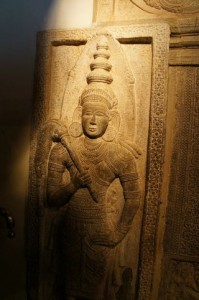 Back at our quaint rest house, the Riverside Holiday Home, we watch a little TV and catch up on world news in the living room and it feels like we really are at home. Sid points out a shield and spears that are typical decoration in Sri Lankan homes. The daughter of the family-run establishment comes upstairs to tell us that dinner is ready and we go down to a delicious family-style dinner. The table is off the kitchen where you can see mother and daughter preparing tea and it makes it feel even more like home. We are joined by a French couple at dinner who arrived in Sri Lanka with no real plan. They picked up a driver at the airport and each day they decide where to go next. It sounds like a pretty adventurous way to travel to me and I look forward to more of my own adventures with Sid and Pradeep tomorrow.
Back at our quaint rest house, the Riverside Holiday Home, we watch a little TV and catch up on world news in the living room and it feels like we really are at home. Sid points out a shield and spears that are typical decoration in Sri Lankan homes. The daughter of the family-run establishment comes upstairs to tell us that dinner is ready and we go down to a delicious family-style dinner. The table is off the kitchen where you can see mother and daughter preparing tea and it makes it feel even more like home. We are joined by a French couple at dinner who arrived in Sri Lanka with no real plan. They picked up a driver at the airport and each day they decide where to go next. It sounds like a pretty adventurous way to travel to me and I look forward to more of my own adventures with Sid and Pradeep tomorrow.
